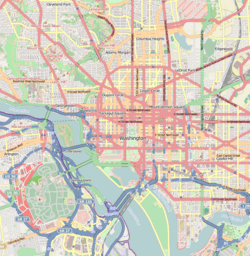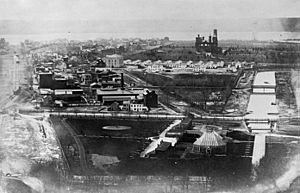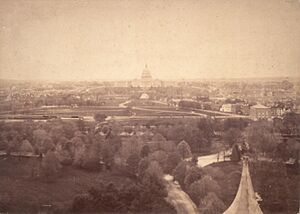Armory Square Hospital facts for kids
Quick facts for kids Armory Square Hospital |
|
|---|---|
| Part of military hospitals in the United States | |
| Washington, D.C. | |
 |
|
| Coordinates | 38°53′16″N 77°01′14″W / 38.8877778°N 77.0205556°W |
| Site information | |
| Controlled by | Union Army |
| Site history | |
| Built | 1862 |
| In use | 1862–1865 |
| Demolished | 1964 |
| Battles/wars | American Civil War |
The Armory Square Hospital was a special hospital for the Union Army during the American Civil War. It was located in Washington, D.C., on the National Mall. The hospital was open from 1862 to 1865.
It stood near the Smithsonian Castle and the Capitol. The hospital had 12 main sections, called wards. These wards stretched across the Mall all the way to the old Canal. Today, the National Air and Space Museum is in the same spot where the hospital once stood.
Contents
History of the Armory Square Hospital
Building the Armory
In 1856, President Franklin Pierce looked for a good place to build an armory. An armory is a place to store weapons and military gear. He wanted a safe place in Washington, D.C.
Experts looked at five different spots. They suggested a place near B Street South and Sixth Street West. This spot was central and had lots of open space. It was also easy to get to from other parts of the city.
The experts also noted there was plenty of government land nearby. This land could be used for future building or for military parades. Based on these ideas, the Armory building was built that same year. It was built right next to the canal.
The Hospital's Purpose
The American Civil War started in 1861. President Abraham Lincoln asked Doctor Willard Bliss to set up hospitals in and around Washington, D.C. The Armory Square Hospital was one of these hospitals. It was built in 1862 on the land around the city's Armory.
The hospital had 1,000 beds in twelve large wards. It also had extra tents for patients. These beds were for soldiers wounded in battles in Virginia. Wounded soldiers came across the Potomac River by boat. They arrived at city docks like the Fish Wharf. They also came across the Long Bridge.
The Armory Square Hospital was the closest hospital to where the steamboats arrived. Because of this, it often treated the most seriously wounded soldiers. Some soldiers received end-of-life care there. Others had more surgeries or treatments. They stayed until they were well enough to go home or move to another hospital.
Volunteers and Famous Visitors
Many people from the northern states came to help at the hospitals. They worked as nurses and support staff. Dr. Bliss became the hospital's superintendent. He continued to work in Washington, D.C., after the war.
One famous volunteer was the poet Walt Whitman. He came to Washington, D.C., from New York. He heard his brother might be wounded. After finding his brother was only slightly hurt, Whitman saw how much other soldiers were suffering. He decided to volunteer.
Whitman visited wounded soldiers in the hospitals. He became close friends with many of them. He also raised money to buy supplies for them. This experience greatly influenced his writing. In his poem The Wound Dresser, he wrote about his time there. He said he spent a lot of time at Armory Square Hospital. This was because it had the worst cases and the most suffering.
President Lincoln also visited the Armory hospital in 1863. Amanda Akin Stearns, a nurse, wrote about his visit in her memoir. She said it was sad to see him go from bed to bed. He gave each soldier a warm handshake. She heard that Lincoln was very interested in this hospital. He even suggested planting flowers between the wards.
Hospital chaplains also helped the soldiers. They gave out books and other reading materials. They also offered comfort and advice.
The Hospital Newspaper
The Armory Square Hospital Gazette was the hospital's own newspaper. The first issue came out on January 6, 1864. The newspaper said it wanted to record the important events in a soldier's life at the hospital.
The Gazette was published for several months. It gave patients news and things to read. It also recognized staff for their hard work. The last issue was printed on August 21, 1865.
The war ended after the Surrender at Appomattox on April 9, 1865. Fewer wounded soldiers needed care. So, military leaders decided the Armory hospital was no longer needed. It closed in the summer of 1865.
The last newspaper issue reflected on the hospital's time. It said thousands of brave soldiers had been treated there. It mentioned that almost every type of wound and disease had been seen. The article hoped that such a terrible war would never happen again. It also said that people learned many lessons within the hospital walls. These lessons included patience, forgiveness, and true courage.
After the Hospital Closed
After the hospital closed, the Armory building was used for storage. Later, it became home to the United States Fish Commission. In January 1964, the building was torn down. This made way for the National Air and Space Museum.
Images for kids








